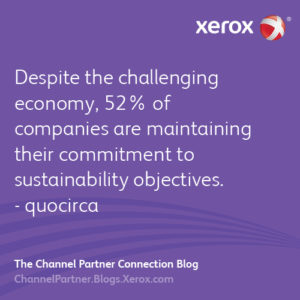
For all of the good reasons to audit and optimize an organization’s print assets, none strikes home quite like environmental awareness. More than most corporate initiatives, green IT efforts just feel right.
Pressure is mounting on businesses of all sizes to green up their IT, making sustainability a top priority for many business decision-makers even in tough economic times. In their Sustainable Print Agenda study, research firm Quocirca found 52 percent of European businesses polled said that they feel strongly about maintaining their commitment to sustainability objectives.
Real financial benefits
These businesses are finding that, in addition to being morally cool, environmental responsibility also reaps real financial benefits in the form of reduced waste, lower supplies costs and trimmed utility bills. It’s no surprise, then, that print solution providers are anxious to help their clients on the road to greener and more sustainable systems and processes. From assessments through device management and ongoing performance reviews,channel partners are leading the way to more eco-friendly printing options that can improve compliance and security and contribute to the bottom line.
Six steps for channel partners
Make a thorough environmental impact assessment
Channel partners should start calculating the client’s eco-posture and carbon footprint by detailing energy consumption, paper use and total supply costs associated with the printer fleet. Focus on identifying places where the client can reduce environmental impact with a balanced deployment of devices and management tools to decrease energy, paper and consumables use.
Focus on energy consumption
With cars, it’s miles per gallon; with print hardware, the onus is on the channel partner to recommend products that meet the latest ENERGY STAR requirements — a badge that indicates devices are up to 40 percent more energy-efficient than non-certified gear. Printers and multi-function printers that warm up quickly and feature sleep and toner-saving modes also put the squeeze on power bills. Combine these with print management tools that can route jobs to the most efficient device and watch the client’s energy use dwindle.
Use MFPs to integrate workflows
MFPs are often most valuable for what they don’t print. With a capable MFP, users can scan, store and share documents digitally when appropriate. Switching paper-trails to digital with MFPs and associated workflow management tools is a great way to improve the client’s productivity and reduce their paper and consumables use.
Reel in wasted paper
There’s two sides to every story … and to every sheet of printer paper. Why not set the client’s devices to print on both sides by default? Also, enabling pull printing — a security and confidentiality feature that requires a user PIN at the device — can save reams of paper wasted on prints left sitting in output trays and reprints made for no good reason.
There are two sides to every story and every sheet of paper, why not print on both sides by default?
Preach recycling as a two-way street
Of course you want the client to take advantage of programs that take back and reuse things like toner and print cartridges, but you also want to make sure the organization is dutiful about recycling its paper waste and is purchasing recycled or sustainably sourced consumables. A well-rounded bi-directional recycling strategy can lead to considerable environmental savings, particularly in terms of carbon emissions.
Measure, manage and report
Ultimately, you’ll want to show the fruits of your labor to the client in a concise form that details how much your thoughtful and expertly delivered print services program is saving in overall supplies and energy consumption. Integrated reporting gives you a way to provide the client with visibility into the environmental impact of their print infrastructure, and it gives you a key tool for continuous improvement and attached sales.
(This article was first published on IT:Connect & Expand, a Channelnomics blog presented by Xerox for managed service providers.)
Subscribe to the Channel Partner Connection and receive email updates when we publish a new article.




Ok
Thanks for commenting Kim